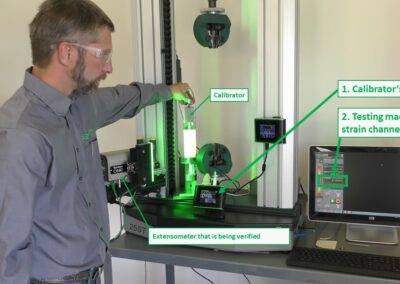Epsilon ONE® – Advantages
What sets Epsilon ONE apart from other non-contacting extensometers?
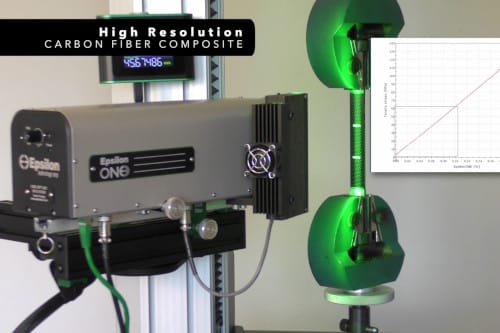 Resolution, Accuracy, and Speed
Resolution, Accuracy, and Speed
Epsilon ONE’s performance is a result of optics and algorithm technologies that are combined for high data rates, resolution and accuracy:
- Real time data rate: 300-3000 Hz
- Resolution: <0.5 µm quasistatic, <2.5 µm dynamic, <0.1 µm creep; Typical RMS resolution at typical settings
- Extensometer Accuracy Class: ISO 9513 Class 0,5 and ASTM E83 Class B-1 or better, typical, for gauge lengths ≥10 mm
As a result, Epsilon ONE is equipped with the accuracy and fine resolution required to measure modulus, offset yield, stress-strain curves, and strain at failure for all high-modulus materials. Precision Telecentric lenses and well-aligned grips are recommended for these applications.
Always On, Always Real Time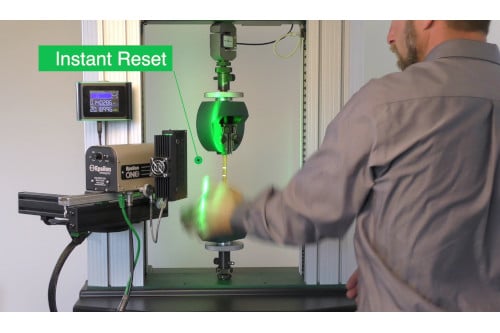
Epsilon ONE overcomes one of the biggest barriers to widespread use of non-contact extensometers: too many steps when using them. Epsilon ONE is always running and measuring strain or searching for marks using its Automatic Mark Detection. As soon as marks are detected, Epsilon ONE is measuring strain in real time. Epsilon ONE doesn’t have to be started and stopped for each specimen like most video extensometers and DIC systems.
The result is Instant Reset – Epsilon ONE is ready for testing in under 2 seconds.
See these features in the Faster Testing video.
Epsilon ONE does not require a separate computer, and strain output is always in real time at data rates up to 3000 Hz.
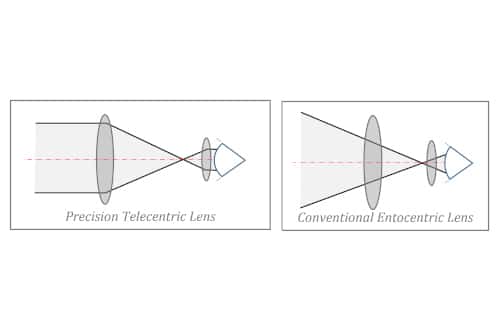 Telecentric Design
Telecentric Design
Precision Telecentric lenses are one of the most important choices available when purchasing non-contact extensometers.
Many applications involve specimens that straighten, such as specimens with a coil set, or grips that are free to align under tensile loading. These “out of plane” motions can cause inaccuracies with conventional lenses because the image of the specimen seen by the camera will be larger or smaller, causing a strain reading that is a measurement error.
These inaccuracies can be large enough to cause the extensometer to default to a lower, inadequate ISO or ASTM accuracy class.
Unlike conventional lenses, telecentric lenses are insensitive to potential inaccuracies caused by out-of-plane motions. With a telecentric lens, the image of the test specimen seen by the camera’s sensor is the same size even if the specimen moves closer to the Optics Package or further away.
The benefit: full strain measurement accuracy is maintained even if the specimen or grips move out of the testing axis (“out of plane”) during the test. Conventional entocentric lenses, which are widely used by other manufacturers of non-contact extensometers, cannot match this performance.
ONE-78PT, ONE-130PT, and ONE-52PT models have precision telecentric lenses.
See the effect of out-of-plane motion in this video ▶Learn more about this important topic in this Tech Note.
Laser Assist Alignment System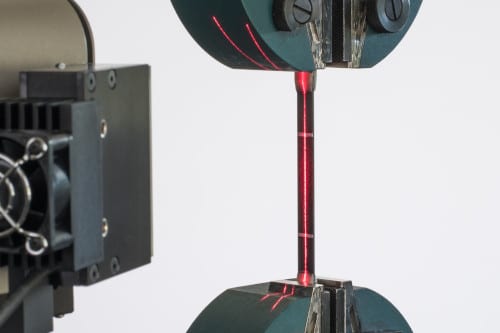
Setup is faster and more robust with the Laser Assist Alignment System.
Epsilon ONE’s built-in factory aligned lasers provide two functions:
• Spot-checking specimen alignment
• Setting distance to the specimen – eliminates the need for calibration grids or gauge length bars
Epsilon ONE is factory calibrated – just set the distance to the specimen, set your controller to take Epsilon ONE’s calibrated ±10V input, and start testing.
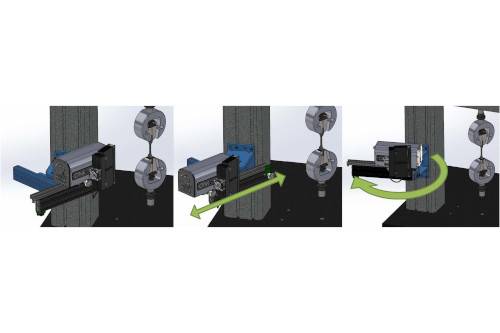 Rigid Load Frame Mounting
Rigid Load Frame Mounting
Very stiff load frame mounting is critical for any optical strain measurement system. Epsilon has engineered solutions that fit any test frame. Epsilon ONE’s mounting systems include swing-away and linear retraction features, and allow the Optics Package to be positioned anywhere it needs to be for testing.
The linear retraction feature combines with Epsilon ONE’s Laser Assist Alignment System for accurate Optics Package alignment and positioning. The mounting and alignment work as a system to eliminate a common source of errors with other non-contact extensometers. See it in the Overview video.
Easier to Use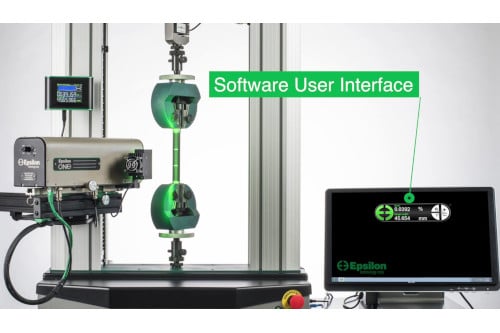
Using Epsilon ONE is simple by design.
Instant Reset uses Epsilon ONE’s automatic mark detection and “always on” features to make test prep literally a wave of your hand. Epsilon ONE will reset its gauge length measurement in one second and you are ready to test.
A Software User Interface is included that provides digital displays and a system status indicator.
An Advanced UI can be accessed to set system parameters.
The optional Touch Interface (see a demo ▶) has digital readouts, a specimen brightness display, system status indication, and access to all Epsilon ONE settings and system functions. The Touch Interface can be placed very close to the specimen, which is most helpful when the test system’s computer is not near the test area.
Epsilon ONE is factory calibrated and does not require calibration grids or gauge length bars, saving a great deal of time.
Verification is Just Like a Clip-On Extensometer
Epsilon ONE is verified using a mechanical extensometer calibrator just like a clip-on extensometer. Contrasting lines are applied to the calibrator where the clip-on extensometer would be normally attached. The Epsilon ONE is then positioned at the correct working distance using its built-in lasers, and then verification can begin. Verification can be carried out by the customer if they have access to a mechanical extensometer calibrator, or by a calibration service provider.

